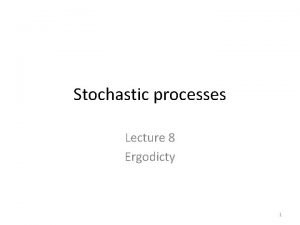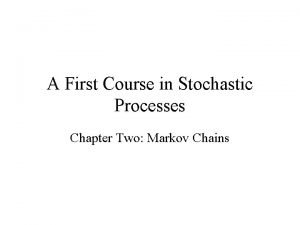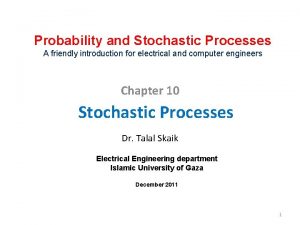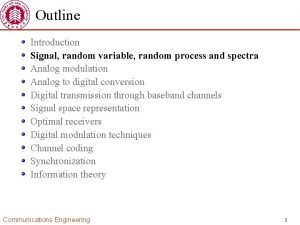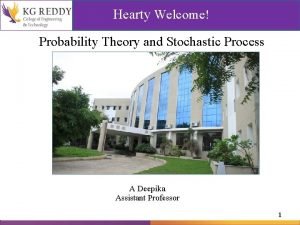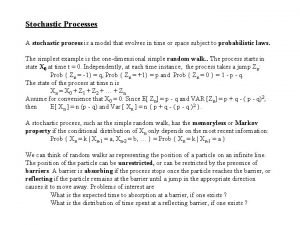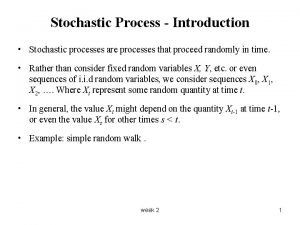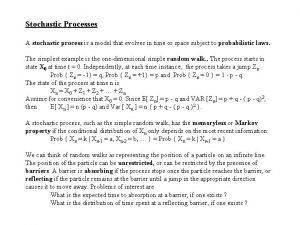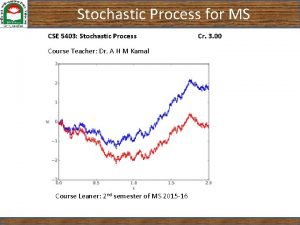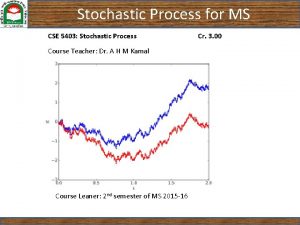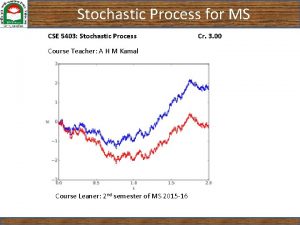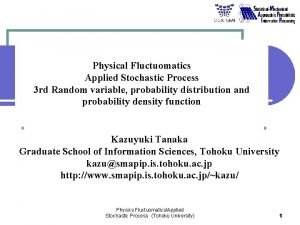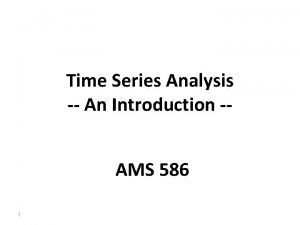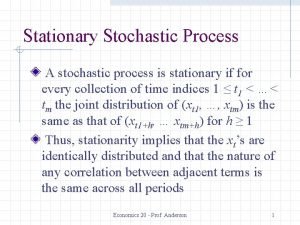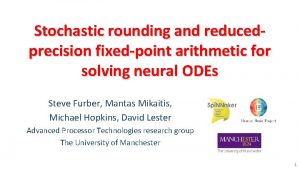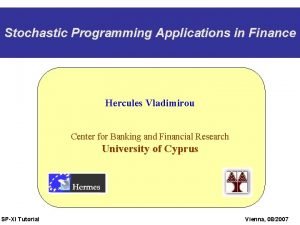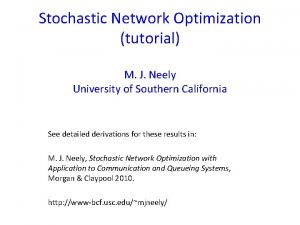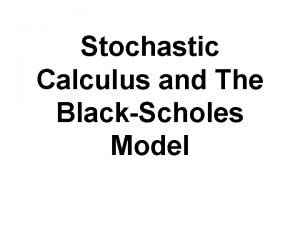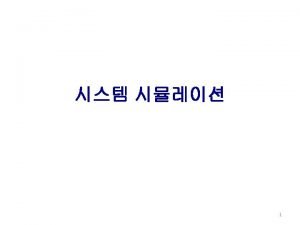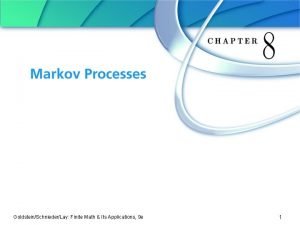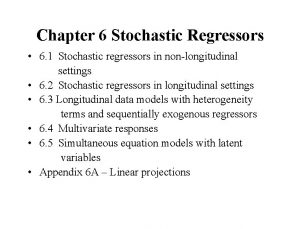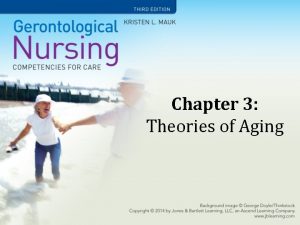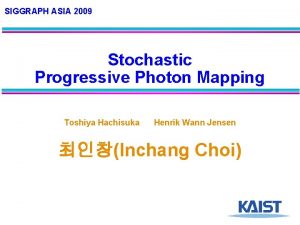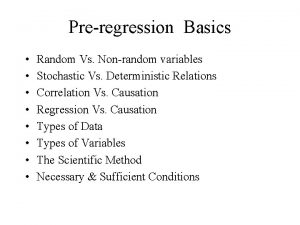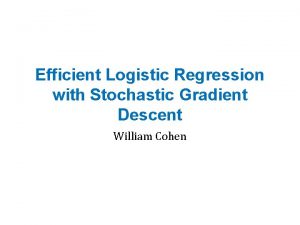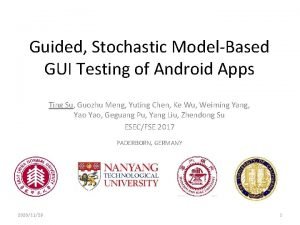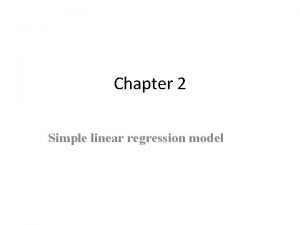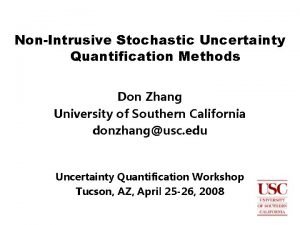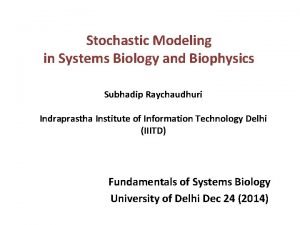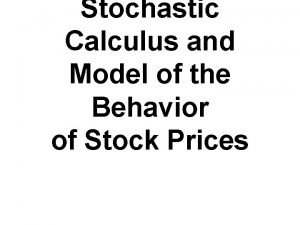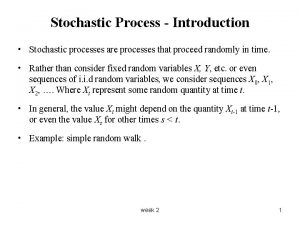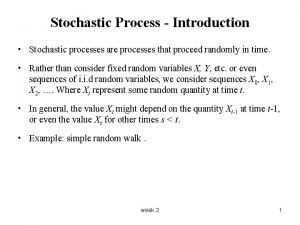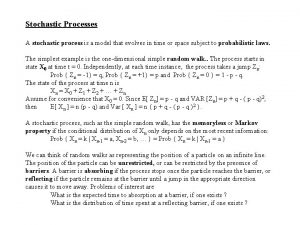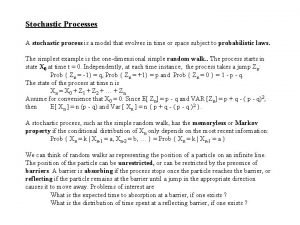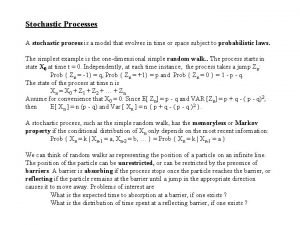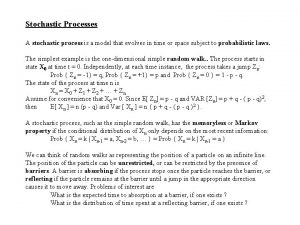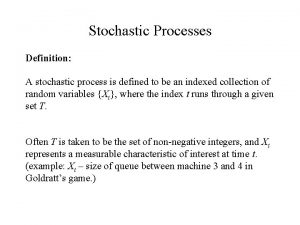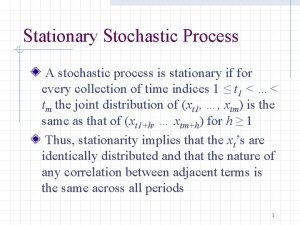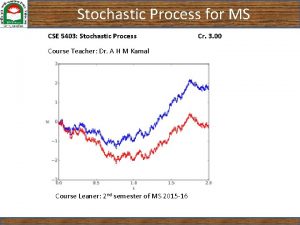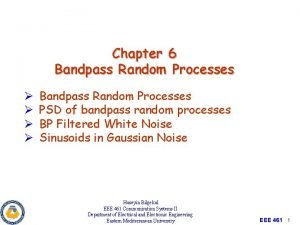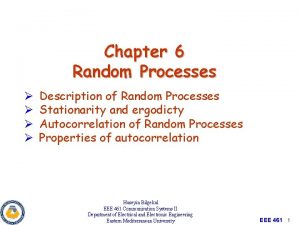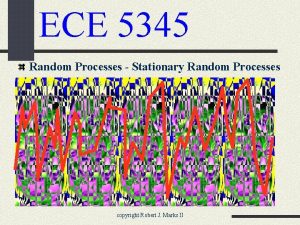Stochastic processes Lecture 8 Ergodicty 1 Random process























![Properties of autocorrelation and crosscorrelation • Auto-correlation: Rxx(t 1, t 1)=E[|X(t)|2] When WSS: Rxx(0)=E[|X(t)|2]=σx Properties of autocorrelation and crosscorrelation • Auto-correlation: Rxx(t 1, t 1)=E[|X(t)|2] When WSS: Rxx(0)=E[|X(t)|2]=σx](https://slidetodoc.com/presentation_image_h/b7112b7600a72bb770e9d6ec1fd7d275/image-24.jpg)












- Slides: 36

Stochastic processes Lecture 8 Ergodicty 1

Random process 2

3

Agenda (Lec. 8) • Ergodicity • Central equations • Biomedical engineering example: – Analysis of heart sound murmurs 4

Ergodicity • A random process X(t) is ergodic if all of its statistics can be determined from a sample function of the process • That is, the ensemble averages equal the corresponding time averages with probability one. 5

Ergodicity ilustrated • statistics can be determined by time averaging of one realization 6

Ergodicity and stationarity • Wide-sense stationary: Mean and Autocorrelation is constant over time • Strictly stationary: All statistics is constant over time 7

Weak forms of ergodicity • The complete statistics is often difficult to estimate so we are often only interested in: – Ergodicity in the Mean – Ergodicity in the Autocorrelation 8

Ergodicity in the Mean • A random process is ergodic in mean if E(X(t)) equals the time average of sample function (Realization) • Where the <> denotes time averaging • Necessary and sufficient condition: X(t+τ) and X(t) must become independent as τ approaches ∞ 9

Example • 10

Ergodicity in the Autocorrelation • Ergodic in the autocorrelation mean that the autocorrelation can be found by time averaging a single realization • Where • Necessary and sufficient condition: X(t+τ) X(t) and X(t+τ+a) X(t+a) must become independent as a approaches ∞ 11

The time average autocorrelation (Discrete version) N=12 12

Example (1/2) Autocorrelation • A random process – where A and fc are constants, and Θ is a random variable uniformly distributed over the interval [0, 2π] – The Autocorraltion of of X(t) is: – What is the autocorrelation of a sample function? 13

Example (2/2) • The time averaged autocorrelation of the sample function • Thereby 14

Ergodicity of the First-Order Distribution • If an process is ergodic the first-Order Distribution can be determined by inputting x(t) in a system Y(t) • And the integrating the system • Necessary and sufficient condition: X(t+τ) and X(t) must become independent as τ approaches ∞ 15

Ergodicity of Power Spectral Density • A wide-sense stationary process X(t) is ergodic in power spectral density if, for any sample function x(t), 16

Example • 17

Essential equations 18

Typical signals • 19

Essential equations Distribution and density functions First-order distribution: First-order density function: 2 end order distribution 2 end order density function 20

Essential equations Expected value 1 st order (Mean) • 21

Essential equations Auto-correlations • 22

Essential equations Cross-correlations • In the general case • In the case of WSS 23
![Properties of autocorrelation and crosscorrelation Autocorrelation Rxxt 1 t 1EXt2 When WSS Rxx0EXt2σx Properties of autocorrelation and crosscorrelation • Auto-correlation: Rxx(t 1, t 1)=E[|X(t)|2] When WSS: Rxx(0)=E[|X(t)|2]=σx](https://slidetodoc.com/presentation_image_h/b7112b7600a72bb770e9d6ec1fd7d275/image-24.jpg)
Properties of autocorrelation and crosscorrelation • Auto-correlation: Rxx(t 1, t 1)=E[|X(t)|2] When WSS: Rxx(0)=E[|X(t)|2]=σx 2+mx 2 • Cross-correlation: – If Y(t) and X(t) is independent Rxy(t 1, t 2)=E[X(t)Y(t)]=E[X(t)]E[Y(t)] – If Y(t) and X(t) is orthogonal Rxy(t 1, t 2)=E[X(t)Y(t)]=E[X(t)]E[Y(t)]=0; 24

Essential equations PSD • Truncated Fourier transform of X(t): • Power spectrum • Or from the autocorrelation – The Fourier transform of the auto-correlation 25

Essential equations LTI systems (1/4) • Convolution in time domain: Where h(t) is the impulse response Frequency domain: Where X(f) and H(f) is the Fourier transformed signal and impluse response 26

Essential equations LTI systems (2/4) • Expected value (mean) of the output: – If WSS: • Expected Mean square value of the output – If WSS: 27

Essential equations LTI systems (3/4) • Cross correlation function between input and output when WSS • Autocorrelation of the output when WSS 28

Essential equations LTI systems (4/4) • PSD of the output • Where H(f) is the transfer function – Calculated as the four transform of the impulse response 29

A biomedical example on a stochastic process • Analyze of Heart murmurs from Aortic valve stenosis using methods from stochastic process. 30

Introduction to heart sounds • The main sounds is S 1 and S 2 – S 1 the first heart sound • Closure of the AV valves – S 2 the second heart sound • Closure of the semilunar valves 31

Aortic valve stenosis • Narrowing of the Aortic valve 32

Reflections of Aortic valve stenosis in the heart sound • A clear diastolic murmur which is due to post stenotic turbulence 33

Abnormal heart sounds 34

Signals analyze for algorithm specification • Is heart sound stationary, quasi-stationary or non-stationary? • What is the frequency characteristic of systolic Murmurs versus a normal systolic period? 35

exercise • Chi meditation and autonomic nervous system 36
 Ergodicty
Ergodicty A first course in stochastic processes
A first course in stochastic processes Stochastic process
Stochastic process Stochastic processes
Stochastic processes Dn0jx
Dn0jx Asynchronnous
Asynchronnous Stochastic process introduction
Stochastic process introduction Stochastic process modeling
Stochastic process modeling Stochastic process
Stochastic process Stochastic process
Stochastic process Stochastic process
Stochastic process Stochastic process
Stochastic process Component of time series
Component of time series Stationary stochastic process
Stationary stochastic process Concurrent processes are processes that
Concurrent processes are processes that 01:640:244 lecture notes - lecture 15: plat, idah, farad
01:640:244 lecture notes - lecture 15: plat, idah, farad Random assignment vs random sampling
Random assignment vs random sampling Random assignment vs random selection
Random assignment vs random selection Stochastic rounding
Stochastic rounding Stochastic programming
Stochastic programming Divbar
Divbar Deterministic and stochastic inventory models
Deterministic and stochastic inventory models Put call formula
Put call formula Stochastic vs dynamic
Stochastic vs dynamic Absorbing stochastic matrix
Absorbing stochastic matrix Stochastic regressors
Stochastic regressors Non stochastic theory of aging
Non stochastic theory of aging Stochastic progressive photon mapping
Stochastic progressive photon mapping Known vs unknown environment
Known vs unknown environment Non stochastic variable
Non stochastic variable Logistic regression stochastic gradient descent
Logistic regression stochastic gradient descent Guided, stochastic model-based gui testing of android apps
Guided, stochastic model-based gui testing of android apps Population regression function definition
Population regression function definition Stochastic uncertainty
Stochastic uncertainty Stochastic vs probabilistic
Stochastic vs probabilistic Stochastic vs probabilistic
Stochastic vs probabilistic Stochastic calculus
Stochastic calculus
